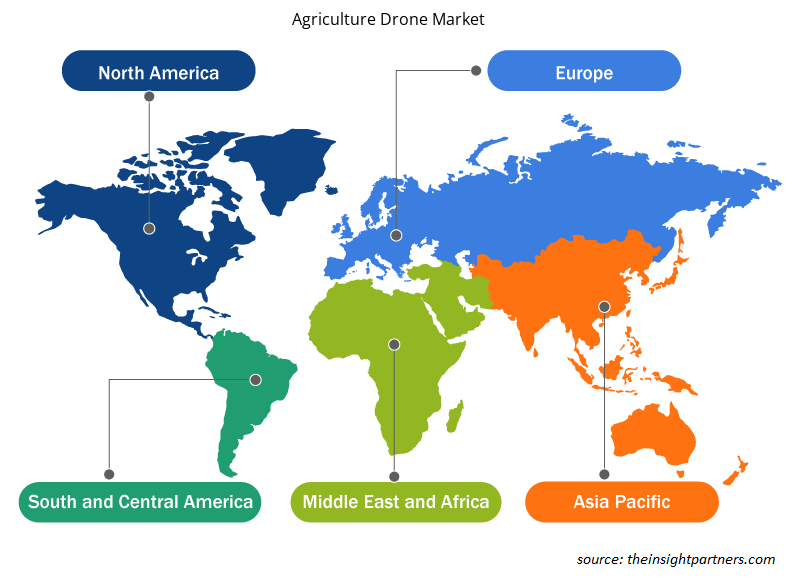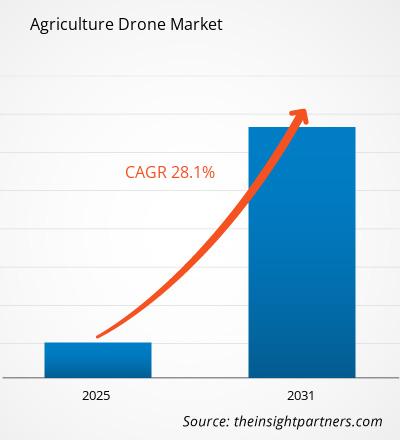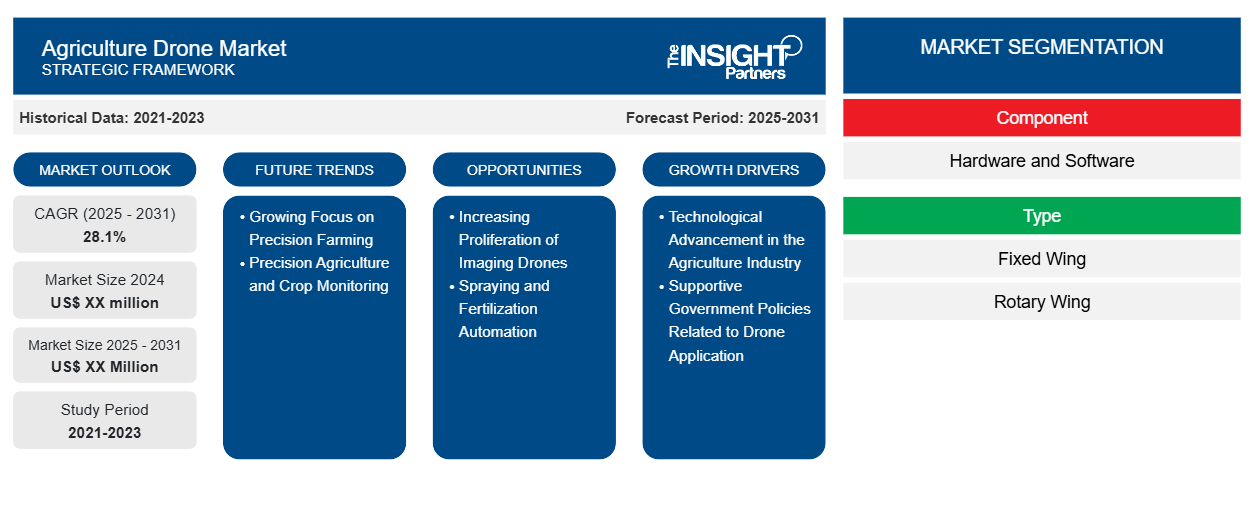预计 2023 年至 2031 年期间农业无人机市场的复合年增长率为 28.1%,市场规模将从 2023 年的 XX 百万美元扩大到 2031 年的 XX 百万美元。
报告按组件(硬件和软件)、类型(固定翼和旋翼)、农业地点(室内和室外)、农产品类型(大田作物、水果和蔬菜、奶制品和牲畜等)、农场规模(小型和中型作物和大型作物)、应用(精准农业、牲畜监测、智能温室等)进行细分。全球分析进一步细分为区域和主要国家。报告以美元为单位提供上述分析和细分的价值。
报告目的
Insight Partners 发布的《农业无人机市场》报告旨在描述当前形势和未来增长、主要驱动因素、挑战和机遇。这将为各种商业利益相关者提供见解,例如:
- 技术提供商/制造商:了解不断变化的市场动态并了解潜在的增长机会,从而能够做出明智的战略决策。
- 投资者:对市场增长率、市场财务预测以及整个价值链中存在的机会进行全面的趋势分析。
- 监管机构:监管市场政策和警察活动,旨在最大限度地减少滥用行为,维护投资者的信任和信心,维护市场的完整性和稳定性。
农业无人机市场细分
成分
- 硬件和软件
类型
- 固定翼
- 旋翼机
耕作地点
- 室内的
- 户外的
农产品种类
- 大田作物
- 水果和蔬菜
- 奶制品和牲畜
- 其他的
农产品种类
- 大田作物
- 水果和蔬菜
- 奶制品和牲畜
- 其他的
定制此报告以满足您的需求
您可以免费定制任何报告,包括本报告的部分内容、国家级分析、Excel 数据包,以及为初创企业和大学提供优惠和折扣
-
获取此报告的关键市场趋势。这个免费样品将包括数据分析,从市场趋势到估计和预测。
农业无人机市场增长动力
- 农业行业的技术进步:数字化和软件应用程序集成化的日益普及,用于监控农田的整体运营效率,预计将推动全球农业无人机市场的增长。
- 与无人机应用相关的政府支持政策:政府越来越重视精准农业,因为精准农业需要满足全球对食品日益增长的需求,预计将支持农业无人机市场的增长。政府对飞行无人机的支持政策也预计将在预测期内推动农业无人机市场的扩张。
农业无人机市场未来趋势
- 精准农业日益受到关注:农业无人机还可以通过管理适当的浇水、收割和施肥时间表来促进精准农业。因此,农场监控软件、作物管理技术和数字航空成像技术等先进技术的利用是市场的主要驱动因素。
- 精准农业和作物监测:无人机在农业领域的应用越来越广泛,它使农民能够实时监测作物健康、土壤状况和灌溉需求。借助高分辨率摄像头和传感器,无人机可以提供数据,帮助农民做出明智的决策,通过瞄准需要关注的特定区域来提高产量并降低成本。
农业无人机市场机会
- 成像无人机的普及率不断提高:数字成像潜力以及无人机传感器有望为农民提供有关其土地的潜在信息。此外,突然的气候变化也给农业部门带来了挑战,这推动了对农业无人机等智能解决方案的需求,以提高公司生产力和农作物产量。此外,无人机农业提供的航拍图像可以揭示灌溉问题、土壤变化和真菌侵染等众多问题,并作为农业中用于调查农作物以及时发现并发症的一套指导方针。
- 喷洒和施肥自动化:无人机也成为自动喷洒杀虫剂、除草剂和肥料的必备工具。这些无人机配备先进的喷洒系统,可确保均匀分布,减少化学废物,提高操作效率。这一趋势使农民能够更精确地施用药物,最大限度地减少对环境的影响,同时提高作物产量。
农业无人机市场区域洞察
Insight Partners 的分析师已详细解释了预测期内影响农业无人机市场的区域趋势和因素。本节还讨论了北美、欧洲、亚太地区、中东和非洲以及南美和中美洲的农业无人机市场细分和地理位置。

- 获取农业无人机市场的区域具体数据
农业无人机市场报告范围
| 报告属性 | 细节 |
|---|---|
| 2023 年的市场规模 | XX 百万美元 |
| 2031 年市场规模 | XX 百万美元 |
| 全球复合年增长率(2023 - 2031) | 28.1% |
| 史料 | 2021-2022 |
| 预测期 | 2024-2031 |
| 涵盖的领域 |
按组件
|
| 覆盖地区和国家 |
北美
|
| 市场领导者和主要公司简介 |
|
农业无人机市场参与者密度:了解其对业务动态的影响
农业无人机市场正在快速增长,这得益于终端用户需求的不断增长,而这些需求又源于消费者偏好的不断变化、技术进步以及对产品优势的认识不断提高等因素。随着需求的增加,企业正在扩大其产品范围,进行创新以满足消费者的需求,并利用新兴趋势,从而进一步推动市场增长。
市场参与者密度是指在特定市场或行业内运营的企业或公司的分布情况。它表明在给定市场空间中,相对于其规模或总市场价值,有多少竞争对手(市场参与者)存在。
在农业无人机市场运营的主要公司有:
- AeroVironment 公司
- AgEagle 航空系统公司
- 大疆
- 无人机部署
- 精密鹰公司
- 第三元素航空有限公司
免责声明:上面列出的公司没有按照任何特定顺序排列。

- 了解农业无人机市场顶级关键参与者概况
主要卖点
- 全面覆盖:报告全面涵盖了农业无人机市场的产品、服务、类型和最终用户的分析,提供了整体概况。
- 专家分析:报告基于对行业专家和分析师的深入了解而编写。
- 最新信息:该报告涵盖了最新信息和数据趋势,确保了其与业务的相关性。
- 定制选项:此报告可以定制以满足特定客户要求并恰当地适应业务策略。
因此,农业无人机市场研究报告有助于引领解读和了解行业情景和增长前景。尽管可能存在一些合理的担忧,但本报告的总体优势往往大于劣势。
- 历史分析(2 年)、基准年、预测(7 年)及复合年增长率
- PEST和SWOT分析
- 市场规模、价值/数量 - 全球、区域、国家
- 行业和竞争格局
- Excel 数据集
近期报告
相关报告
客户评价
购买理由
- 明智的决策
- 了解市场动态
- 竞争分析
- 客户洞察
- 市场预测
- 风险规避
- 战略规划
- 投资论证
- 识别新兴市场
- 优化营销策略
- 提升运营效率
- 顺应监管趋势























 获取免费样品 - 农业无人机市场
获取免费样品 - 农业无人机市场